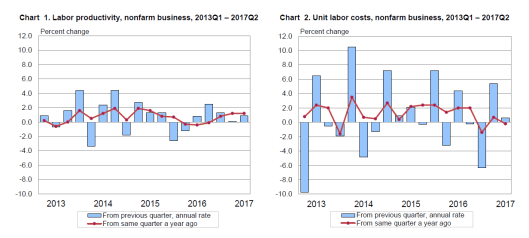The BLS report on preliminary Productivity and Costs, Second Quarter 2017 shows nonfarm business productivity increased 0.9 percent during the second quarter of 2017.
Productivity is defined as “real” inflation-adjusted output divided by aggregate hours worked.
The quarterly number is very good, but revisions were massive and the overall trend is dismal. More importantly, the measurement is FUBAR. First, let’s dive into the report.
Labor Productivity and Unit Costs
Supposedly, the charts are seasonally adjusted, but the second chart on unit labor costs suggests something is seriously wrong. Alternatively, or additionally, there are lots of data-gathering flaws.
Revisions
In regards to the possibility of data gathering flaws, let’s consider real hourly compensation revisions.
Year-Over-Year Productivity – Real Output Per Hour
The last time year-over-year productivity was up by more than 2.0% was nearly seven years ago!
I downloaded the above data all the way back to 1948 to calculate a long term trend.
Productivity Trend 1948-Present
Spotlight 2016
In 2016, productivity was -0.3% in the first quarter, -0.4% in the second quarter, -0.1% in third quarter and +0.8% in the fourth quarter.
THe BLS notes “Annual Average productivity growth in the nonfarm business sector in 2016 was revised down to a decrease of 0.1 percent.”
This was the first annual productivity decline since 1982.
Productivity Understated?
A Spring 2016 Brookings study asked Is Productivity Slowing or Are We Just Measuring It Wrong?
Here is the Brooking’s conclusion: “Productivity Slowdown is Structural, not a Measurement Problem”.
A Vox report says Productivity is Understated Due to Offshore Profits.
US multinational enterprises may legally shift profits from high tax countries (like the US) to low tax countries (like Bermuda). This column uses unpublished survey data to show how this causes part of the US economic activity generated by these multinational enterprises to be attributed to their overseas affiliates, leading to an understatement of measured US GDP and, in turn, productivity. Profit-shifting activity has increased significantly since the mid-1990s, resulting in an understatement of the growth rate of US productivity.
Lost in the Debate
Before one can measure productivity, one needs to accurately measure hours worked and real output.
Real output implies an accurate measurement of inflation. The term “real” means “inflation-adjusted”.
My Take – Productivity Measurement is Totally “FUBAR”
-
Hours worked are understated. Because of cell phones and the internet, people work countless unreported hours, even on vacation. Those are hours worked, but neither counted nor paid.
-
At the supervisory level, there is pressure on non-hourly workers to put in more store hours. Think Target, WalMart, McDonald’s everywhere. Supervisors do put in those hours (or they do not advance), and those hours go uncounted.
-
Pressure builds on truckers to make increasingly difficult (timewise) deliveries. This results in changes in trucker logs to keep truckers driving past the statutory limit of 11 hours. Those hours do not count either.
-
Illegal aliens work for less. Home builders and repair crews of all kinds pay illegal aliens less than US citizens. Those wages may or may be reported, but the output (a completed home), is.
-
On the inflation front, the only way one can calculate “real” output or “real” wages is to first calculate inflation. If inflation is understated, even by a minuscule amount, the error changes productivity measurements dramatically.
-
Inflation measurements do not include asset bubbles or even home prices. Rather, the BLS uses Owners Equivalent Rent (OER) as a substitute for home prices. OER alone dramatically skews inflation, sometimes to the high side, but mostly lower.
Totally “FUBAR” Yet Certainly Overstated (Short Synopsis)
Productivity is measured by taking an artificially high estimate of “real” output divided by an underreporting of hours worked.
-
On one hand, we have countless unreported hours worked. This acts to overstate productivity.
-
On the other hand, inflation measurements are complete nonsense. “Real” output is much lower than reported because inflation is understated. This also overstates productivity.
Despite two artificial boots, one in the numerator and the other in the denominator, the productivity trend still heads lower! Thank the inflation tactics of central banks.
This material is based upon information that Sitka Pacific Capital Management considers reliable and endeavors to keep current, Sitka Pacific Capital Management does not assure that this material is accurate, current or complete, and it should not be relied upon as such.
Recommended Content
Editors’ Picks
EUR/USD clings to daily gains above 1.0650

EUR/USD gained traction and turned positive on the day above 1.0650. The improvement seen in risk mood following the earlier flight to safety weighs on the US Dollar ahead of the weekend and helps the pair push higher.
GBP/USD recovers toward 1.2450 after UK Retail Sales data

GBP/USD reversed its direction and advanced to the 1.2450 area after touching a fresh multi-month low below 1.2400 in the Asian session. The positive shift seen in risk mood on easing fears over a deepening Iran-Israel conflict supports the pair.
Gold holds steady at around $2,380 following earlier spike

Gold stabilized near $2,380 after spiking above $2,400 with the immediate reaction to reports of Israel striking Iran. Meanwhile, the pullback seen in the US Treasury bond yields helps XAU/USD hold its ground.
Bitcoin Weekly Forecast: BTC post-halving rally could be partially priced in Premium

Bitcoin price shows no signs of directional bias while it holds above $60,000. The fourth BTC halving is partially priced in, according to Deutsche Bank’s research.
Week ahead – US GDP and BoJ decision on top of next week’s agenda

US GDP, core PCE and PMIs the next tests for the Dollar. Investors await BoJ for guidance about next rate hike. EU and UK PMIs, as well as Australian CPIs also on tap.



